New pharmaceuticals and their generic counterparts are approved every week by the FDA. In 2020, 50 novel drugs were approved by the FDA. While this is great news for those whose health conditions can be better treated and managed with these new drugs or medication costs reduced with the approval of generic formulations, all medications can produce side effects. For people with chronic or serious illnesses that require multiple daily prescription medications, the side effects can be compounded. What you may not realize, is that some of these side effects can significantly impact the eyes, including contributing to dry eye.
Statistics from the Centers for Disease Control show that “… during 2015–2016, almost one-half of the U.S. population used one or more prescription drugs in the past 30 days (45.8%). Prescription drug use increased with age*, and a higher percentage of females (50.0%) than males (41.5%) used prescription drugs, but the pattern varied by age.”
*Prescription drug use increased with age, from 18.0% of children under age 12 years to 85.0% of adults aged 60 and over.
Polypharmacy, the term to describe the use of multiple pharmaceuticals, can create very complex interactions and complications for patients. These interactions can be difficult to predict.
The authors of this study note that oral polypharmacy is the most common cause of dry mouth but has not been investigated as a cause of dry eye. The nervous system mechanism that causes dry mouth as a side effect is the same one that also causes dry eye. Dry eye symptoms can include burning, itching, excessive tearing, foreign body sensation, and blurred vision, among others. Patients and physicians who are not familiar with these common dry eye symptoms may not recognize this effect as a dry eye condition.
Although this study had incomplete data, the authors note that had enough content to recommend that “Clinicians should remember that if a medication causes a dry mouth, it may also cause or aggravate dry eye.” They also hypothesize that medication-induced dry dye and dry mouth may masquerade as primary Sjögren’s Syndrome.
Frederik Fraunfelder, MD, the lead researcher of this paper, started the National Registry of Drug-Induced Ocular Side Effects (NRDIOSE) in 1976. This online registry records ocular side effects and interactions of drugs, chemicals, and herbals.
As a patient, it’s important to be aware of the possibility that your prescription medications may be contributing to your dry eye symptoms. If you suspect this might be the case, talk to your doctor or pharmacist about this possibility and inquire whether there is an adequate substitute that might not have the same adverse effects. Your doctor or pharmacist can look up medications on the NRDIOSE database for reported side effects. Take a few moments to try to remember whether an increase in symptoms coincided with new prescription medication. Don’t forget that over-the-counter (OTC) drugs and nutritional supplements can also have these side-effects. It’s helpful to make a written list to review all of the medications and supplements you take regularly to identify any that might potentially be exacerbating your dry eye symptoms.
This post is part of BostonSight’s archival content and was originally authored by Janice M. Epstein in February 2015. Content has been updated to be current. This content is informational in nature and should not be considered medical advice. Please reach out to your medical professional for questions about your vision.
